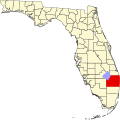2000 census
As of the census [3] of 2000, there were 2,015 people, 1,112 households, and 549 families residing in the town. The population density was 3,389.2 inhabitants per square mile (1,308.6/km2). There were 1,606 housing units at an average density of 2,701.3 per square mile (1,043.0/km2). The racial makeup of the town was 90.62% White (87.8% were Non-Hispanic White), [16] 4.22% African American, 0.10% Native American, 1.74% Asian, 0.99% from other races, and 2.33% from two or more races. Hispanic or Latino of any race were 4.57% of the population.
In 2000, there were 1,112 households, out of which 9.8% had children under the age of 18 living with them, 41.7% were married couples living together, 5.7% had a female householder with no husband present, and 50.6% were non-families. 39.0% of all households were made up of individuals, and 11.5% had someone living alone who was 65 years of age or older. The average household size was 1.81 and the average family size was 2.33.
In 2000, in the town, the population was spread out, with 8.8% under the age of 18, 4.8% from 18 to 24, 30.3% from 25 to 44, 30.6% from 45 to 64, and 25.6% who were 65 years of age or older. The median age was 49 years. For every 100 females, there were 96.0 males. For every 100 females age 18 and over, there were 92.0 males.
In 2000, the median income for a household in the town was $50,284, and the median income for a family was $64,375. Males had a median income of $50,431 versus $32,647 for females. The per capita income for the town was $43,960. About 8.6% of families and 7.1% of the population were below the poverty line, including 10.5% of those under age 18 and 5.5% of those age 65 or over.
As of 2000, English as a first language accounted for 86.65% of all residents, while the mother tongues of French comprised 5.38%, Finnish consisted of 4.52%, Spanish was at 2.42%, and Italian made up 1.02% of the population. [17]
As of 2000, Hypoluxo had the twelfth highest percentage of Canadian residents in the US (tied with four other US areas,) which accounted 5.40% of all residents, [18] while it can be assumed that because of the percentage of Finnish speakers, Finns were around 4.52% of town's population. [19]


